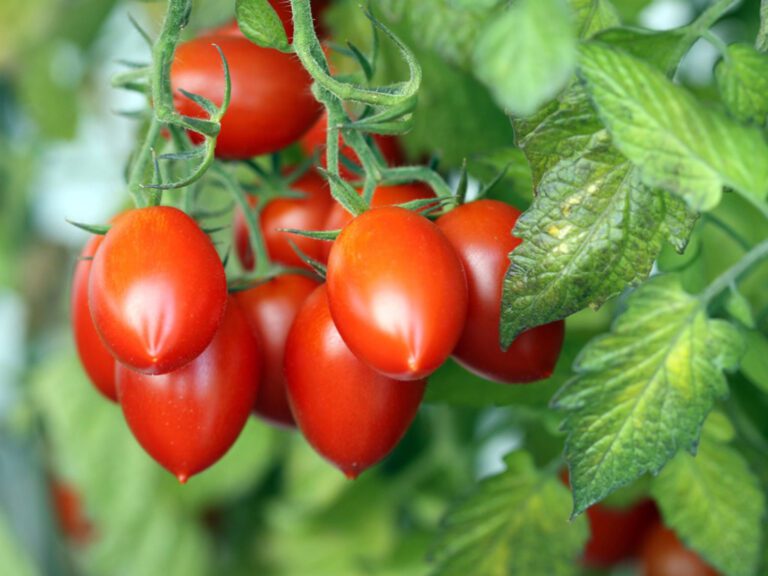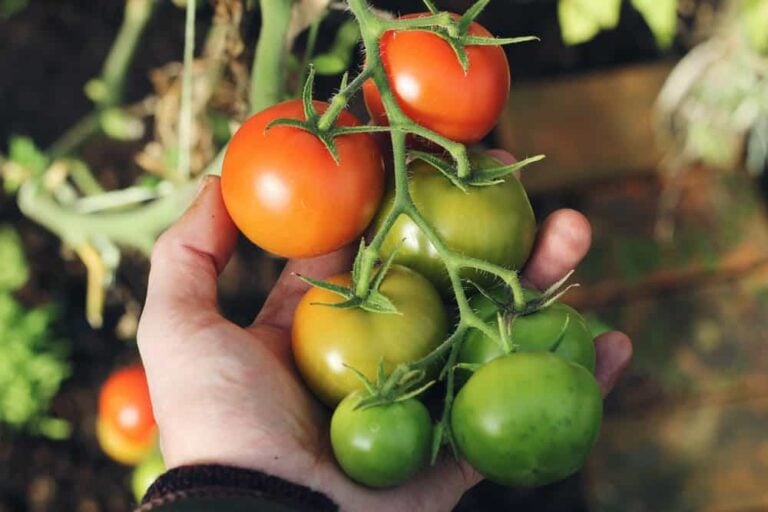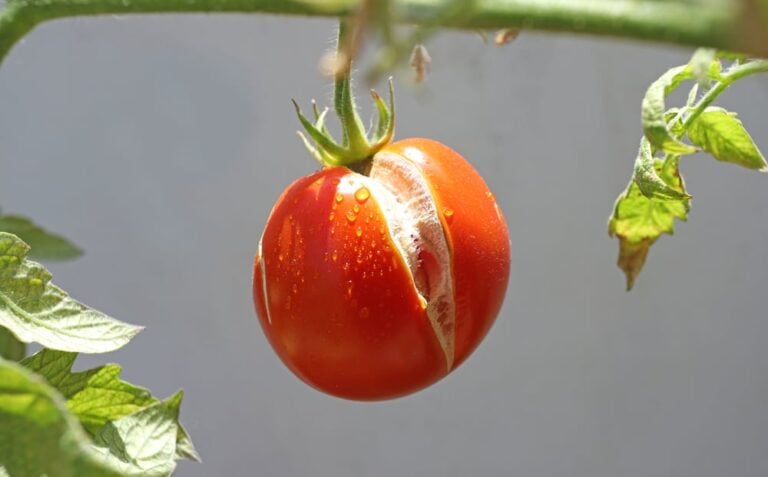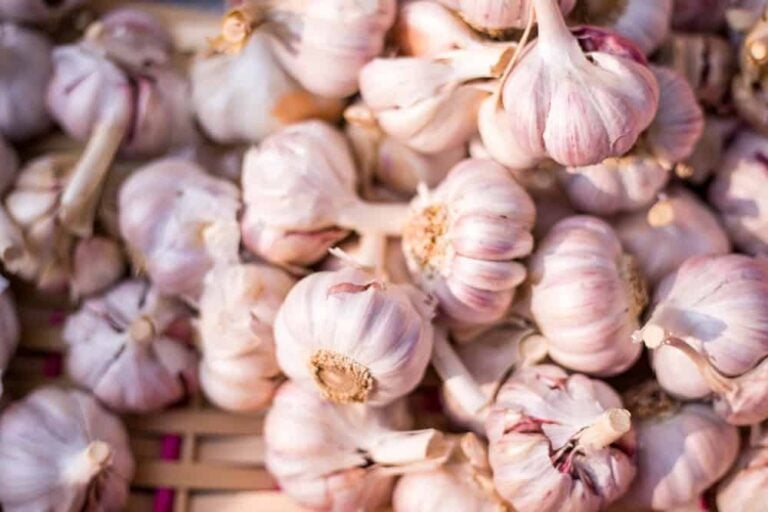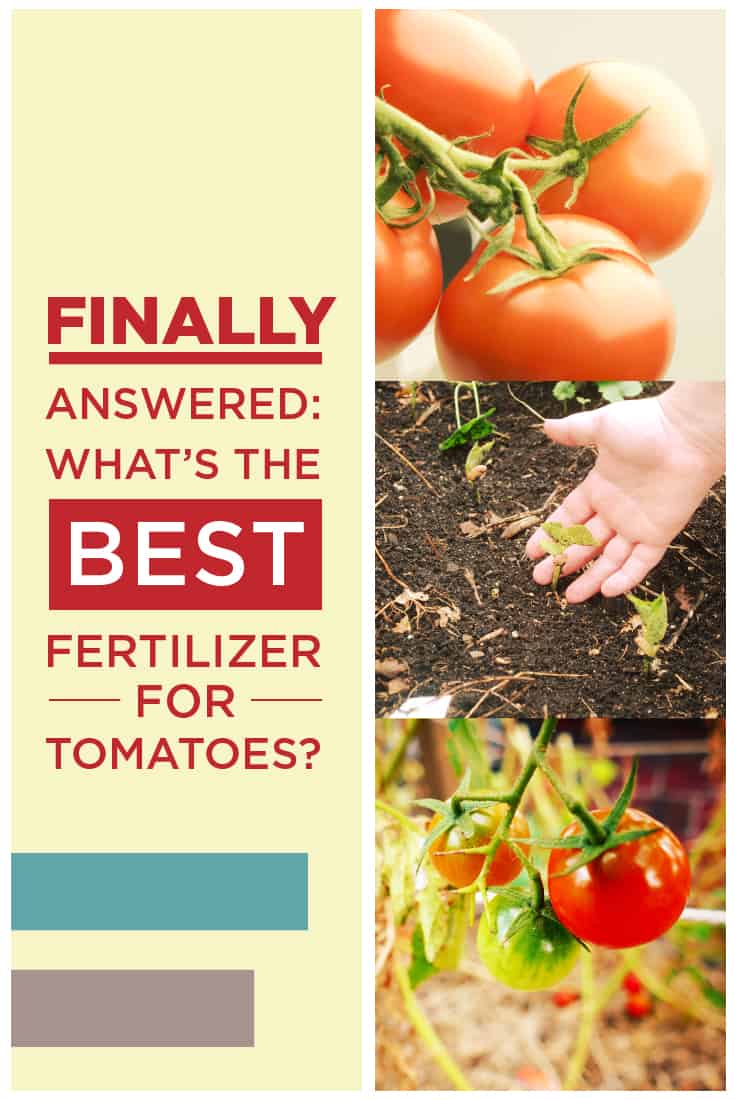When to Pick Tomatoes
Now everyone knows what a tomato is. It’s one of the most used ingredients in food and recipes, especially in Southeast Asian countries, where it is used in every possible dish.
But let’s go into some detail about what tomatoes are. In this article, you will learn what tomatoes are, what time is perfect for you to pick them, and what benefits they provide us all.
So let’s get started!
Tomatoes:
A tomato is a super-food packed with nutrients that benefit a wide range of human body systems. Its nutritional content supports weight loss, heart health, and healthy skin.
There are different sizes and types of tomatoes, which can be cooked and prepared differently. These include stewed tomatoes, cherry tomatoes, soups, raw tomatoes, purees, and juices.
Knowing when to pick yummy red tomatoes is essential if you want to get the best possible quality and flavor from your garden. Color and size alone are not consistent indicators of maturity. Soil fertility, weather conditions, tomato variety, and other factors affect fruit ripening time and coloration. Full-color progress is often hindered after the fruit is ready to be picked. On the positive side, numerous reliable pointers and signs can be used to decide the right time to harvest your luscious red tomatoes.
Check the time to ripeness for the specific tomato varieties you’re growing.
An excellent initial point in deciding when to pick tomatoes is checking the number of days to harvest listed on the plant tag or seed packet. Since there are thousands of tomato varieties of all sizes, shapes, and colors, maturing times can vary from as few as 60 days to over 100 days.
The countdown to the “days to harvest” starts when the sapling is planted in the garden rather than when the seed is sown. Seed sprouting usually takes about a week; then, the sapling should grow at least two groups of true leaves before it’s prepared to be transplanted, so if you’re growing your plants from seeds, the seedling production tallies as much as a month to the entire time to ripeness.
It’s usually better to let the tomatoes develop fully on the plant.
In an emergency, it is completely fine to harvest mature green tomatoes to let them ripen inside the plant. Grocery store traders usually pick the tomatoes when they are just starting to show color so the fruits can mature during shipment or while transporting. But the finest flavor quality and color come from tomatoes that ripen on the vine.
So, what qualifies as mature?
Green tomatoes get a lighter color upon reaching their full size, signifying the start of the maturing process. Around the time the color is halfway matured, the fruit closes off from the main plant. At this point in the ripening process, the tomato develops the remaining way without help from the vine. It can be harvested off the vine without losing its quality, nutritional value, or flavor.
Gardeners are sometimes reluctant to pick slightly green tomatoes, reasoning that the fruits might not produce a good flavor. However, in reality, reaping at any point after the half-color stage sanctions more control over the maturing process without wasting that homegrown flavor.
Stiffness is a good sign of a fully mature tomato.
Firmness is a great way to judge if a tomato is ready to be picked. Entirely red and ripe tomatoes should feel somewhat tender but not messy when you give them a gentle squeeze. At that point, they are entirely ready to eat. The tomatoes should feel firm but not rigid if you are picking at the half-color stage.
Tenderness develops in the fruit as the aroma and color mature on the kitchen counter or the vine. The fruit might have no smell initially, but when they are ready to be cooked or consumed, the tomatoes create a solid earthy, sweet fragrance from their stem ends. As tomatoes can be of several different colors when they are mature and ready to eat, smell and feel are some of the best signs of ripeness.
There are some situations in which you should not wait for the tomatoes to ripen before harvesting them.
Temperatures at over 90 degrees Fahrenheit are not suitable for many of the tomato varieties. High temperatures can make the fruit more vulnerable to sunscald and other warmth-related problems. Additionally, carotene and lycopene, the orange and red pigments that give the fruits their color, cannot properly develop in hot weather. If your tomatoes have achieved their full size but won’t develop color, immediately pick them and let them complete their ripening in an air-conditioned kitchen.
If severe storms or the season-ending cold weather threaten your tomatoes, you can save the green ripe fruits by picking them a little early. Any tomatoes that have reached their full size and turned a light green are believed to be green ripe. Green tomatoes are great for various recipes, like green tomato salsa or fried green tomatoes. Or, at this stage, you can still ripen them indoors. Just place them in a paper container with ethylene-producing fruits such as apples or bananas to assist their ripening.
Picking ripe red tomatoes:
The preferred way to harvest tomatoes is with a clean, sharp pair of garden clippers or pruning shears.
The sharp green leaves that spread out at the top of the fruit are the calyx that once used to protect the flower bud. Some tomatoes separate from the plant efficiently, leaving their calyx behind on the vine. Others separate from the vine taking the calyx and a short stem with them. The branch usually breaks away at a slightly swollen juncture connecting to the plant. A few kinds of tomatoes break away effortlessly only when they are overripe, so they should be picked by cutting them off the vine.
Don’t damage the fruit or plant if you are met with any resistance at the stem while picking your tomatoes. Use a sharp, clean pair of garden clippers or pruning shears to cut the mature tomato from the plant. Hold the fruit with one hand and slice the stem just over the fruit with the other.
Benefits of Tomatoes:
Tomatoes are laden with a substance known as lycopene. It gives them their signature bright red color and helps shield them from the harmful ultraviolet rays of the sun. Similarly, it can help also protect your body cells from destruction. Tomatoes also have vitamins B and E, potassium, and other nutrients.
Immune System:
Lycopene is an antioxidant that fights molecules known as free radicals that can harm your cells and negatively affect your immune system. Because of this, foods high in lycopene, such as tomatoes, might make it improbable to have stomach, prostate, or lung cancer. Some researches show that tomatoes might help prevent diseases in the mouth, pancreas, throat, colon, cervix, and breast.
Heart:
Lycopene can also help lower your levels of cholesterol or LDL and your blood pressure as well. And that, in turn, might lower your chances of getting a heart disease. Other nutrients in these red fruits, like antioxidants called flavonoids, and vitamins B and E, can improve your heart health, too.
The potassium, fiber, choline, and vitamin C content in tomatoes all sustain heart health.
Tomatoes also have folate, which helps to balance homocysteine amounts. Homocysteine is an amino acid which is an outcome of protein breakdown. It is supposed to increase the possibility of heart strokes and attacks. The controlling of homocysteine levels by folate decreases one of the risk features for heart disease.
High potassium intake is also known for shielding the muscles against weakening, conserving bone mineral density, and decreasing the creation of kidney stones.
Eyes:
Tomatoes have substances called zeaxanthin and lutein that can help protect your eyes from the harsh blue light emitted from digital devices like computers and smartphones. They also ease headaches from eyestrain and help keep your eyes from feeling tired. And some research has shown that tomatoes can even make you improbable to have a more severe form of what is considered the leading cause of blindness, i.e., age-related macular deterioration.
Tomatoes can help shield the eyes from light damage.
Tomatoes are loaded with beta-carotene, lycopene, and lutein. These are all strong antioxidants known to protect the eyes against light-induced injuries, the development of cataracts, and AMD.
Lungs:
Some studies have shown that tomatoes can also be helpful to people who have asthma and breathing problems and may help avoid emphysema, a disorder that slowly harms the air sacs in a human’s lungs. That may be because zeaxanthin, lycopene, and lutein, among other antioxidants, battle the harmful materials in tobacco smoke, which is considered the leading cause of emphysema.
Blood Vessels:
Adding more tomatoes to your daily diet can also make you less liable to having a stroke. A stroke happens when blood flow gets interrupted in a part of your brain. Some studies suggest that these fruits can boost your immune system, ease inflammation, keep your blood from clotting, and lower your cholesterol levels. All these factors can help prevent strokes.
Oral Health:
Research has shown that lycopene can help with periodontitis, gum diseases, and gingivitis similarly as it can help prevent cancer – by fighting the free radicals. But consuming lots of raw tomatoes can harm the enamel and coating on your teeth – due to the high quantity of acid – and brushing soon after can make that more damaging. It’s better to wait at least half an hour before you brush your teeth.
Skin:
You’re aware that sunscreen and hats help shield you from the sun, and many of us don’t even leave our residences without an umbrella. Well, the lycopene in these red fruits also can do something for that, probably in the same way it shields the tomatoes. It’s not an alternative to sunscreen; you don’t have to put it directly on your skin. It assists by performing on your cells from inside your body.
Collagen is an essential part of the human body’s hair, skin, nails, and connective tissue. The manufacture of collagen in a body depends on vitamin C. A lack of vitamin C can lead to a disease known as scurvy. Tomatoes also contain vitamin C, which is a powerful antioxidant. Low consumption of vitamin C is associated with amplified damage from smoke, sunlight, and pollution. This can lead to blemishes, sagging skin, wrinkles, and other unpleasant health effects on the skin.
Blood pressure:
Preserving a low sodium intake helps to uphold healthy blood pressure levels. But, increasing potassium intake is just as vital due to its expanding effects on the arteries.
Low sodium and high potassium intake are also related to a 20% decreased risk of dying from all reasons.
Diabetes:
Tomatoes also help diabetic persons, as they are full of fiber. Research has shown that anyone with type 1 diabetes who consumes high-fiber foods has lower blood glucose levels, whereas those with type 2 diabetes can have improved lipids, insulin, and blood sugar levels. One serving of cherry tomatoes provides around 2 grams of fiber. You should consult with your doctor so they can advise you on how many servings to take.
Constipation:
Consuming high fiber and water content diets, like tomatoes, may support regular bowel movements and help with hydration. Tomatoes are often labeled as a laxative fruit.
Pregnancy:
Adequate folate consumption is essential during pregnancy to shield against neural tube faults in newborns. Folic acid is the artificial form of folate. It is accessible through supplements but can also be improved through dietary measures, namely tomatoes.
Although it is recommended that pregnant women take folic acid alternatives and supplements, tomatoes are a great form of naturally-occurring folate. This also applies to women who have the possibility of becoming pregnant in the near future.
Fresh vs. Canned Tomatoes:
Both canned and fresh tomatoes can benefit you, but in diverse ways. Nutrients like lycopene may be easier for your body to consume and break down from canned tomato products compared to fresh tomatoes. However, the heat used to produce them might get rid of some vitamins and other nutrients.

